Barcode Symbology
GS1-128 Barcode (formerly EAN/UPC-128 Barcode)
SSCC labels contain two barcodes that together use 5 data fields, four of which are contained in the bottom barcode. The contents of this barcode are common for major retailers, and include the AI’s for (02) Item, (15) Best Before Date, (10) Lot or Batch Number and (37) Quantity.
The production system recognizes each AI and checks the data to confirm it is the correct type and length. Illegal barcodes are not printed. If you have problems building a correct barcode, please build one AI at a time until the entire barcode is built and correct. The program independently compresses any resulting numeric digits where more than 4 adjacent digits are found, and prints the AIs in brackets as the Human Readable.
More complex AIs can be added to the barcode such as 310n which shows the trade weight in Kg for a Pallet. This contains the number of decimals in the “n” position, hence:
(3102)1225 = 12.25 Kg (3101)1225 = 122.5 Kg (3100)1225 = 1225 Kg
You will REQUIRE the local publication from the GS1 organization in your country, who will verify the barcodes for you where you want to use additional AIs.
There are two basic schemes for production of GS1-128 barcodes.
- Construction from a single field containing the full GS1-128 data. The fields can be either fixed length or delimited. The labels named Delimited use this approach, with delimited data.
- Construction of the barcode is very simple (just the one field), with construction of the data file requiring AIs, and delimiters if the AI data is not full length. For simplicity, use delimiters throughout – even for fixed fields. No overhead is incurred in the finished label.
- We recommend placing the additional field containing GS1-128 data last in the data record.
- Construction from individual fields. In this approach the AIs are inserted ahead of the individual fields. Fields must be delimited for variable data that is short, and masked where required.
- Construction of the barcode is moderately difficult, however data files are simple to generate and contain just the data from your data base or from a FormTrap Delivery tag (Version 7 Associated File field)
FormTrap can provide sample barcode labels and data file that contains both Delimited and Fixed labels.
Delimited Labels:
The “delimited” approach, precedes each AI with a delimiter (~) and the entire text ends in a trailing delimiter.
Working through the barcode text:
Delimiter ~ (any character, such as / or \ or | etc.) AI 02 (item) Item data
Key a valid representation of your Item code
link this to the Item field in your file
Delimiter ~ AI 15 (Use by date) Best Before date Best Before Key in a valid date in yymmdd format (example uses 051231)
link this to the Best Before field in your file
Delimiter ~ AI 10 (Batch or Lot) Lot data
Key in an example batch number for your site
link this to the Lot field in your file
Delimiter ~ AI 37 (Quantity) Quantity data
Key some data, the maximum for your trade units
link this to the Quantity field in your file
Delimiter ~
In this label, the data in the "Delimited" file is already reduced to significant digits only.
Fixed Labels:
The label uses fixed length fields output by your application (fields are space separated in the data file for easy viewing). The barcode inserts AI and delimiter (/) where required. This type of file is normally presented by AS/400 programs as well as some Unix systems. In this sample, variable length AI text is of the required size (6 characters for Lot and 4 characters for Qty).
Working through the text:
AI 02 (Item) Item data
Key a valid representation of your Item code
link this to the Item field in your file
this field is fixed length
field uses a Mod 10 Check Digit which is checked
AI 15 (Use by date) Best Before date
Key in a valid date in yymmdd format (example uses 091231)
link this to the Best Before field in your file
Delimiter / (Lot is variable length, max. 20 characters) AI 10 (Batch or Lot) Lot data
key in 6 digits (or the number of characters in your Lot number),
link this to the Lot field in your file
Delimiter / (Quantity is variable length, max. 8 digits) AI 37 (Quantity) Quantity data
key 4 digits (or whatever your organization's standard length is)
for the pieces in your trade unit,
link this to the Quantity field in your file
Delimiter ~
PDF417 Barcode
PDF417 barcodes are two-dimensional and have additional properties that are easily included into the object by prefixing additional data onto the front of the text string that is converted into the PDF417 barcode. These properties are the Number of Data Character Columns, and Error Correction level (used to assist reading of a damaged or obscured barcode). The defaults are 8 data columns, and Error Correction level of 3 (runs from 1-lowest to 8-highest and impacts the finished size of the barcode. For this application, the default Error Correction level is adequate).
To change Data Columns and/or Security, mask this string to the front of the barcode text:
| ~C~E~ | where C is Columns and E is Error Correction. |
| ~C~~ | Error Correction may be omitted (and defaults to 3). |
This is the definition string and resulting barcode.
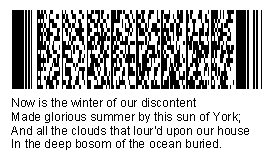
As with all barcodes, you may include constants and data in the
string to be encoded, and from version 8.5.0.2 forward, may apply
Formatting panel attributes to the data.
QR Barcodes
Selecting Quick response (QR) from the list of symbologies
draws a QR code, double click on this to see the text encoded which
is 123.
Selecting symbology
Showing
initial text
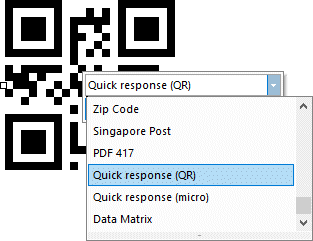
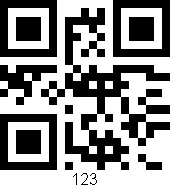
Replace 123 with your string. You can select and link parts of the string to data fields as shown, here selecting PONUMBER and linking this to master field PO.

If your string is large, amend font and size shown for the QR code
in it's normal (no string showing) version ...

... result after text size change, pulling right handle and
double-click.
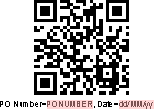
QR Codes have additional properties that may be included into the object by placing additional data onto the front of the text string. These properties are Version and Error Correction (used to assist reading of a damaged or obscured barcode). There are two variations in QR barcodes; Standard (commonly used, has three corner blocks) and Micro (maximum 35 characters, one corner block).
To understand QR Barcodes http://en.wikipedia.org/wiki/QR_code
Standard QR Barcode
Version has the range 1 (low) to 40 (high) and relates to the number and range of characters to be encoded. Version 4 encodes up to 50 ASCII characters. Default is the lowest value that will encode the characters. If the specified version is too low to encode the characters, the minimum version that will is chosen. Scale is the dragged area left to right.
Error Correction has the range 0 (low) to 3 (high). Error correction recovers approximately 7% (low) to 30% (high) of damaged characters in the barcode. Default is 1 (medium).
These are prefix strings for Standard QR Barcodes where the user wants to modify the default values:
| Hello world | No prefix, default values are used |
| ~10~3~Hello world | Sets Version to 10 and Error Correction to 3 |
| ~7~~Hello World | Sets version to 7 with default Error Correction |
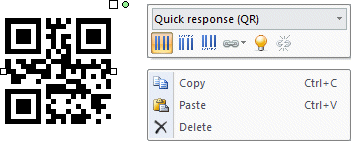 This is "Hello world" at default settings.
This is "Hello world" at default settings.
As with all barcodes, you may include constants and data in the
string to be encoded, and from version 8.5.0.2 forward may apply
Formatting panel attributes to the data.
You will need to select one of the "show text" attributes to
manipulate text, and set back to the "no text"  icon before building.
icon before building.
Micro QR Barcode
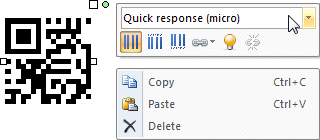 Version has values 3 and 4 available, default is
4.
Version has values 3 and 4 available, default is
4.
Error Correction has the range 0 (low) to 2 (high). Version 3 with Error Correction 2 is not allowed.
This is "Hello world" at default settings.
QR Codes with huge data present issues with access to the characters making up the code. This procedure allows the very long text to be accessed and modified within FTForm Plus. Below shows the text below the code after double-clicking the QR code. The same text is shown word-wrapped next to the QR code.

These are the steps to handle a very long source string for a QR
code and have the QR code draw correctly:
Select anywhere in the string
Press Home to move to the start of the string
Press Shift plus End to select the entire string
Data Matrix
From Version 8.24 onward, NOT present in FTDesign.
This is the ECC 200 version which encodes all of the ACSII
characters, and has Reed-Solomon error correction that recovers
damaged areas of the code.
To understand Data Matrix codes, look here http://en.wikipedia.org/wiki/Data-Matrix.
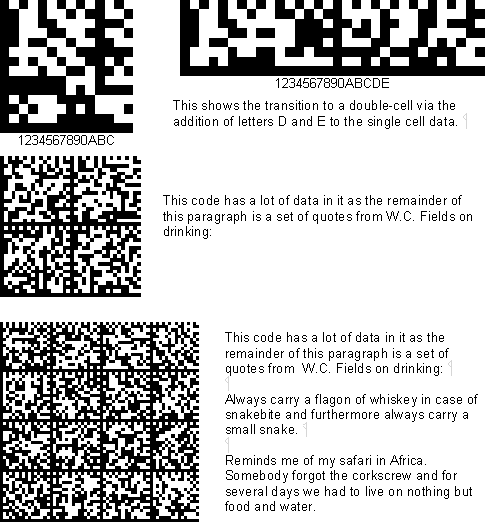
This is an image of Data Matrix codes at a variety of lengths of
data. Data is encoded into cells, two cells produce a rectangular
code, larger amounts of data produce multiple cells formatted as a
square.
To show data, double-click on the code which shows content, data
fields are highlighted. You can link multiple data fields into a
Data matrix code. Non-printable characters may be included.
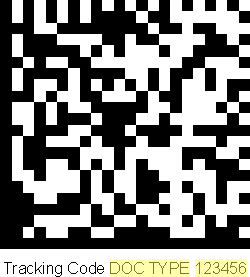
Click Show Data Sources icon ![]() to show field names.
to show field names.

To compress or expand a code, pull the side handles, original and resulting images:
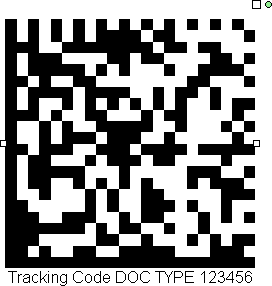 to this
to this 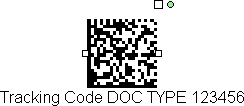
Non-printable characters may be included via an "escape" in the data
in the form \xAA where AA are two hexadecimal
(0-9,a-f) characters representing the ASCII value in hex form.
Escape is case insensitive, \x1e is same as \X1E or
\x1E or \X1e.
Invalid hex values (e.g. \x1h ) substitute the null
character for encoding and no error is reported. These are values
for GS1 encoding:
Record Separator: \x1e
Group Separator: \x1d
These are compressed Data matrix codes, also showing text and data
as a separate object:



Australia Post DPID
This barcode uses the DPID value to generate a barcode to Australia Post specification. The value MUST include a check digit, the picture shows a valid value.

Signapore Post Barcode
This barcode is similar to Australia Post DPID. The value MUST
include a check digit.
FormTrap has been qualified to produce this barcode correctly.
Zip (US Postal) Barcode
Zip encodes Zip, Zip+4 and Zip+4+2 barcodes. Values disregard non-numerics. 5, 9 and 11 digits are encoded, other numbers of digits are not encoded.



